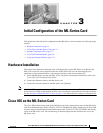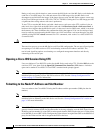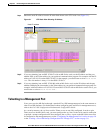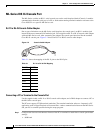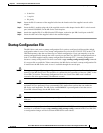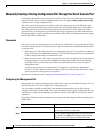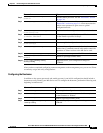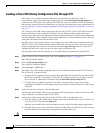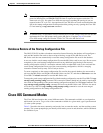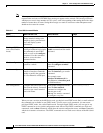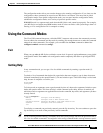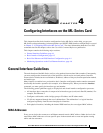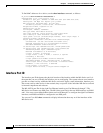
3-7
Cisco ONS 15310-CL and Cisco ONS 15310-MA Ethernet Card Software Feature and Configuration Guide R8.5
78-18133-01
Chapter 3 Initial Configuration of the ML-Series Card
Startup Configuration File
After you have completed configuring remote management on the management port, you can use Telnet
to remotely assign and verify configurations.
Configuring the Hostname
In addition to the system passwords and enable password, your initial configuration should include a
hostname to easily identify your ML-Series card. To configure the hostname, perform the following task,
beginning in enable mode:
Step 3
Router(config)# enable password
password
Sets the enable password. See the “Passwords” section
on page 3-6.
Step 4
Router(config)# enable secret
password
Allows you to enter an enable secret password. See the
“Passwords” section on page 3-6. A user must enter the
enable secret password to gain access to global
configuration mode.
Step 5
Router(config)# interface
type number
Router(config-if)#
Activates interface configuration mode on the interface.
Step 6
Router(config-if)# ip address
ip-address subnetmask
Allows you to enter the IP address and IP subnet mask
for the interface specified in Step 5.
Step 7
Router(config-if)# no shutdown
Enables the interface.
Step 8
Router(config-if)# exit
Router(config)#
Returns to global configuration mode.
Step 9
Router(config)# line vty
line-number
Activates line configuration mode for virtual terminal
connections. Commands entered in this mode control the
operation of Telnet sessions to the ML-Series card.
Step 10
Router(config-line)# password
password
Allows you to enter a password for Telnet sessions.
Step 11
Router(config-line)# end
Router#
Returns to privileged EXEC mode.
Step 12
Router# copy running-config
startup-config
(Optional) Saves your configuration changes to
NVRAM.
Command Purpose
Command Purpose
Step 1
Router# configure terminal
Activates global configuration mode.
Step 2
Router(config)# hostname
name-string
Allows you to enter a system name. In this example, we
set the hostname to “Router.”
Step 3
Router(config)# end
Returns to privileged EXEC mode.
Step 4
Router# copy running-config
startup-config
(Optional) Copies your configuration changes to
NVRAM.





